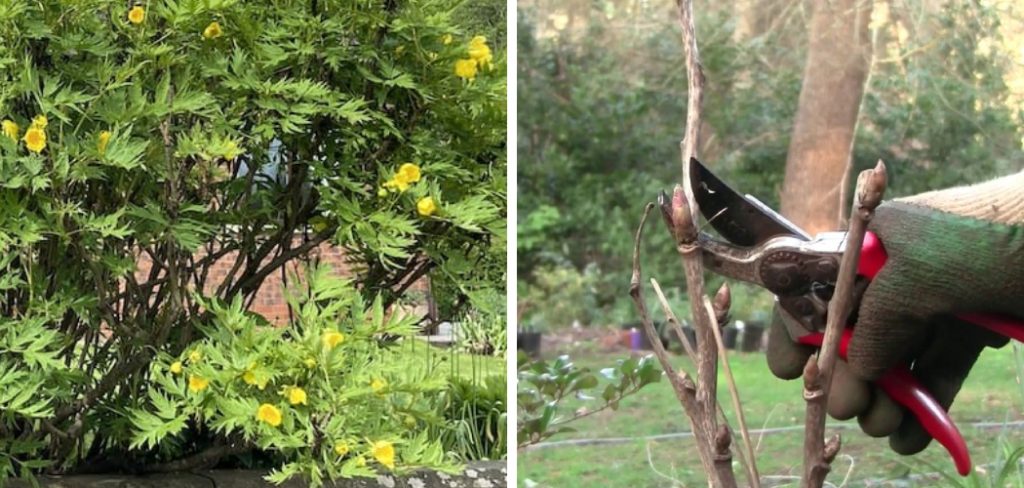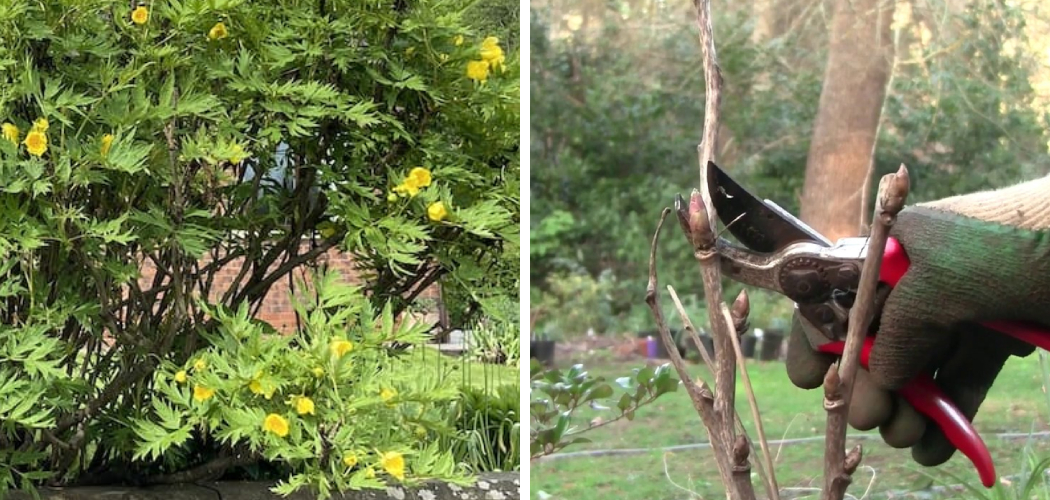To prune a tree peony, start by removing dead or damaged branches using clean and sharp pruning shears. Then, prune any crowded or crossing branches to promote airflow and prevent diseases.

Understanding The Pruning Process
Pruning tree peonies is an important process that helps promote healthy growth and beautiful blooms. It is best to prune tree peonies in late winter or early spring before new growth begins. To prune a tree peony, you will need a few tools including sharp pruning shears or a small saw, gloves, and disinfectant spray.
Start by removing any dead or damaged branches, cutting them back to healthy tissue. Next, thin out the center of the tree by removing any overcrowded or crossing branches. This will improve air circulation and reduce the risk of disease.
Finally, prune back any overly long branches to maintain a balanced shape. By following these pruning guidelines, you can help your tree peony thrive and produce stunning flowers.
Step-By-Step Guide: How To Prune A Tree Peony
Pruning a tree peony is an essential task to maintain its growth and enhance flowering. Before starting, assess the peony’s growth and condition. Remove any dead or damaged branches to promote healthy growth. Next, it’s important to cut back overgrown branches to shape the plant and maintain its overall form.
Here are some tips to ensure future growth and abundant flowering: prune after the last frost, always use clean and sharp tools, make cuts at a 45-degree angle, and remove any weak or inward-facing branches. Remember to be cautious and not over-prune, as this can hinder the peony’s ability to produce flowers.
By following these steps, you can keep your tree peony healthy and beautiful for years to come.
Addressing Specific Pruning Challenges
Pruning tree peonies can be a challenge, especially when dealing with young or newly planted ones. One strategy is to prune lightly to encourage healthy growth. Another consideration is how to rejuvenate an older, neglected peony. In this case, it may be necessary to prune more aggressively, removing dead or diseased branches.
Different peony varieties also require specific pruning techniques. Some may need to be pruned immediately after flowering, while others benefit from a dormant season pruning. Understanding the needs of each variety and following proper pruning practices will ensure the health and beauty of your tree peonies.
So, whether it’s addressing challenges for young plants or reviving neglected ones, pruning tree peonies requires careful consideration and knowledge of the specific variety.
Essential Care Practices
Pruning a tree peony is essential for its growth and overall health. Proper watering and fertilizing is crucial to keep the plant thriving. It is recommended to water deeply but infrequently, allowing the soil to dry out between waterings. Adding a slow-release fertilizer in early spring and again in the fall will provide the necessary nutrients.
Mulching around the base of the tree peony helps retain moisture, suppress weeds, and moderate soil temperature. It’s important to avoid piling mulch against the stems, as this can cause rot. Depending on the variety and size of the plant, supporting and staking may be necessary to prevent it from flopping over under the weight of its blooms.
By following these care practices, your tree peony will flourish and reward you with stunning flowers season after season.
Troubleshooting Common Pruning Issues
Pruning a tree peony is an essential task to maintain its health and promote abundant flowering. However, it’s common to encounter issues while pruning. One common problem is dealing with pests and diseases that may arise after pruning. It’s important to regularly inspect the tree peony for any signs of infestation or infection.
By taking preventive measures, such as using organic pest control methods and practicing good hygiene in the garden, you can minimize the risk of pests and diseases affecting your pruned tree peony. Additionally, it’s crucial to protect your pruned tree peony from winter damage.
Applying a layer of mulch around the base and covering it with a burlap or fleece wrap will provide insulation and shield it from extreme cold. Finding the right balance between pruning and flowering is essential for optimal results. It’s recommended to prune your tree peony in early spring before new growth appears, ensuring that the pruning does not interfere with the blooming process.
Taking Your Pruning Skills To The Next Level
Pruning a tree peony takes your skills to the next level, with advanced techniques required for experienced gardeners. To achieve desired shapes and forms, it’s essential to follow these expert tips. Creating both artistic and functional pruned tree peonies adds beauty to your garden.
By carefully shaping the branches, you can enhance the overall appearance and structure of the peony tree. Remember to prune during the dormant season to avoid damaging the plant. Start by removing any dead, diseased, or weak branches, and then focus on shaping the plant.
Use clean and sharp pruning tools to make precise cuts, preventing any tearing or crushing of the branches. With proper care and attention, you can master the art of pruning tree peonies and create stunning displays in your garden.
Frequently Asked Questions Of How To Prune A Tree Peony
Do You Cut Back Tree Peonies In The Fall?
Yes, tree peonies should be cut back in the fall for optimal growth and flowering.
What Happens If You Prune A Tree Peony?
Pruning a tree peony helps maintain shape, encourage new growth, and promote better flower production.
How Do You Winterize Tree Peonies?
To winterize tree peonies, prune them in late autumn, remove dead foliage, and mulch with straw or leaves.
How Do You Take Care Of Tree Peonies?
To care for tree peonies, provide well-draining soil, partial sun, regular watering, and prune dead branches.
Conclusion
Pruning a tree peony is an essential task that helps maintain its health, shape, and overall beauty. By following the right techniques, you can ensure the longevity and productivity of your tree peony. Start by removing dead or damaged branches, enhancing air circulation, and promoting new growth.
Pruning also helps control the size of the plant and encourages more abundant and vibrant flowers. Remember to use clean and sharp tools, making clean cuts to minimize the risk of diseases. It is important to prune your tree peony at the correct time, which is usually in late winter or early spring.
By taking these steps, you can enjoy a thriving tree peony that showcases stunning blooms year after year. Pruning may seem intimidating, but with proper knowledge and practice, you can master this skill and enhance the beauty of your garden.
Happy pruning!

